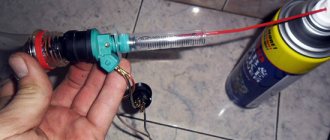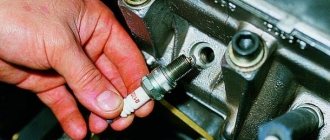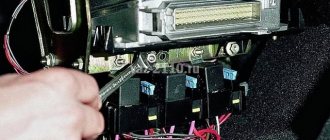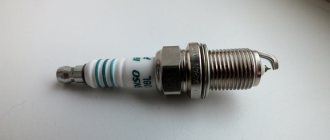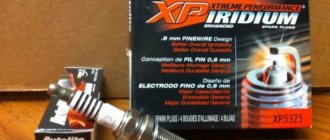This article will tell you what kind of carbon deposits there are on spark plugs and how to do a simple cleaning of your car’s spark plugs. Formally, car spark plugs are considered consumables.
Then what's the point of courting them? But the experience of generations of car enthusiasts has noted that the performance of the engine, its power and gluttony depend on the condition of the spark plugs.
A driver who is more or less involved in the work of his four-wheeled assistant will undoubtedly spend part of his time when servicing the car inspecting the spark plugs, and if necessary, also caring for them.
To analyze the performance of a spark plug, there is no need to resort to testing it on complex equipment. The appearance of the electrodes and the thermal insulator cone can tell an experienced driver a lot.
Soot on spark plugs - what does it tell you?
1. If a wet, black carbon deposit has formed on the cone of the spark plug, this means that the spark plug is too “cold” for the engine. But this effect can be caused by an increased level of oil in the engine crankcase, as well as wear of the piston rings and cylinders.
2. Dry carbon deposits of the same black color indicate a lack of load on the engine or a “cold” spark plug for your engine model.
3. If the spark plug appears to your attention with a dry, clean cone of white or light color, very often with traces of melting, then this means that either the spark plug is too “hot” or the ignition adjustments contribute to early ignition of the combustible mixture.
A normally functioning candle is characterized by the absence of any soot and all kinds of traces of melting, and the color of its metal parts will be in shades from light brown to light gray.
A normally functioning spark plug can withstand 25-35 thousand kilometers. If the engine is used intensively (you drive more than 15 thousand kilometers per year on your car), it is recommended to regularly clean the spark plugs and adjust the gap.
If your car’s mode is more gentle and does not exceed the specified annual mileage, then servicing the spark plugs can be limited to twice a year. As a rule, they coincide with the seasonal maintenance of your car when changing from the autumn-winter operating cycle to the spring-summer one and vice versa.
Video:
How to clean spark plugs yourself
To clean candles, do not use sharp metal objects. Set the awl, screwdriver and knives aside. A scratched spark plug insulator will quickly become covered with soot, and it will clog the electrodes, rendering the spark plug unusable.
For this event, a brush with thin steel hairs, small plastic and wooden plates are suitable, but the best way is to clean the candles chemically.
We begin the chemical cleaning procedure To do this, wash it in gasoline and dry it. At the next stage, we immerse the candles in a solution of ammonium acetate (also known as ammonium acetate) of 20 percent concentration. Let it soak for half an hour at a gentle boil.
You can not bring it to a boil, but then how can you ensure that the temperature of the liquid does not drop beyond the 90-degree mark on the Celsius scale. We clean the boiled candles with a nylon (or any other, but hard) brush, rinse thoroughly with hot water and dry.
To carry out these operations you need a well-ventilated room or they need to be carried out outside. Do not breathe in the vapors of acetic acid released when the ammonium acetate solution boils.
In washed and dried spark plugs, we adjust the electrode gap.
By carefully bending the side electrode, we achieve the desired dimensions. To measure the current gap we use a cylindrical feeler gauge. Wear of the spark plug leads to the appearance of a notch in the side electrode, which is difficult to determine with a flat probe. As a result of such a measurement, you can get an erroneous result that does not correspond to the actual size of the gap.
We determine the malfunction of spark plugs by plaque
The color of the coating determines a specific engine malfunction:
- Lime color on candles, piston bottom, valve plates indicate incomplete combustion of engine oil residues coming from the crankcase. Factors affect engine stability, mixture filling under the piston, and spark penetration.
When engine oil burns incompletely, limescale appears on the spark plugs.
- Dark rough soot indicates that the engine is running on a rich mixture. This is facilitated by faulty adjustment of the spark distributor and power system. The situation leads to excessive fuel consumption. The plaque is eliminated by itself if you crank the engine at 4000 rpm.
Black soot indicates an overly rich combustible mixture.
- Resinous deposits, the cause of which is considered to be a cold, that is, non-working part. A sign of this is insufficient compression, a “foreign” spark plug, or problems with high-voltage wires. Low pressure in the cylinder serves as the basis for deformation, valve cracks, and pusher defects.
One of the reasons for tar deposits is a malfunction of the ignition system.
These incidents lead to intense wear of the cylinder mirror, and the engine begins to “trouble.” The best solution to the problem is to replace the spark plugs.
- Light color, the presence of tiny metal grains within the electrode (central), which is a factor in frequent overheating of the spark plug. This is a mismatch with the engine, late ignition. The reason may be hidden in a faulty cooling system, which leads to cracks in the valve plates and burning of the piston. There are cracks in the insulator, small pieces of which fly under the piston, damaging the cylinder walls.
White carbon deposits with a shine on the central electrode indicate excessive overheating of the spark plug.
Is carbon deposits normal or a malfunction?
Everything is easy and simple, if your power unit is in order, then there should be no carbon deposits! Of course, the spark plugs will be slightly black, but this is normal; on a working engine, the central insulator will almost always be clean.
But if it is overgrown with either black oily deposits, black flakes, red deposits, etc. This is not normal, it may indicate a malfunction:
- Power systems
- Ignition systems
- Fuel (perhaps it was filled with low quality or with metallized additives, this will cause a red coating)
- Valve seals or oil rings may be leaking
- Trivial wear of spark plugs (their electrodes need to be replaced)
Even if you fill in with the wrong gasoline, with metallized additives (a red coating will appear). That is, change the gas station in the future, the spark plugs will clean themselves, in the combustion chamber several hundred kilometers away.
Symptoms of dirty candles
Before talking about how to clean carbon deposits from spark plugs at home, you need to tell car enthusiasts about the signs that indicate the need for preventative repair work.
Spark plugs in internal combustion engines need to be cleaned when:
- the car “troubles” (one of the engine cylinders does not function);
- Dense gases with a bluish tint come out of the exhaust pipe in abundance;
- jerking becomes more frequent while moving;
- there is difficulty starting the power unit and starting from a standstill;
- fuel consumption increases.
What do misfires mean? You can find the answer to this question in the content material of our specialist.
By the level of contamination of the spark plug, you can determine a cylinder that is operating unstably. The spark plug in the problematic engine compartment will be the dirtiest; the remaining elements will have acceptable soot. In general, in general, you should not be surprised by the presence of carbon deposits: this is the result of the normal functioning of the “engine”.
It is important to pay attention to the structure and thickness of the layer.
Even if you installed new spark plugs, a thin, uniform layer of soot will appear on the working surface after 250 - 300 kilometers.
Causes of malfunctions
Spark plugs and malfunctions are associated with the appearance of:
- Wear, usually of the side electrode.
- Crack in the insulator body.
- Melting of both electrodes.
- Erosion – thinning of the side element.
- Carbon deposits.
Wear
Types of spark plug wear
Failure to replace spark plugs in a timely manner leads to distortion of the gap and, as a result, sparking with the consequences of poor starting of the car. Wear of the side electrode is caused by additives contained in gasoline . The result is missed sparks and engine detonation. Products are subject to replacement.
Cracked spark plug body and insulator
Even unnoticeable cracks or visually visible chips or chips on the body of the insulator are considered reasons for replacement.
When using spark plugs with cracks, current leaks through the insulator to the spark plug body
Defects appear as a result of:
- wear and tear (natural).
- Detonation due to early ignition angle.
- Low octane fuels.
- Low quality insulator.
- Incorrectly set gap.
A defective spark plug insulator causes current leakage. This fact leads to a decrease in the spark discharge between the electrodes . And this is already a difficult engine start, low throttle response, jolts when moving from a stop, unstable idle speed.
Microcracks are easy to detect in the dark of the day or in the darkness of the garage.
Reflow
Melting of electrodes is a manifestation of serious overheating
The appearance of rough, porous soot. Occurs due to thermal stress, low octane gasoline, early ignition cycle . Defects in the distributor (distributor) or valves cannot be excluded. Mixture formation and ignition are checked, spark plugs are changed.
Erosion
Signs of erosion appear on the electrodes of spark plugs that have exhausted their service life.
Caused by oxidation and incorrect gap setting. Erosion will dominate the interaction of lead in gasoline . This presence creates a chemical reaction with, for example, nickel electrode material.
Layering
A pronounced brown-yellow, thick layer of plaque is evidence of the presence of additives (ethyl) in the fuel .
Being a current conductor, carbon deposits lead to distortion of spark formation (at high loads). Since it is useless to remove such deposits, there is a need for replacement.
Cleaning iridium spark plugs
They are worth mentioning separately, because the service life of these products reaches 100 thousand km (provided that high-quality fuel is used), they ignite the mixture at minus 30 and below, they cost a lot and it’s a pity to throw them away after use. Therefore, the desire to extend the service life of expensive products is quite natural.
It is very easy to damage the thin protective layer of electrodes: physical and chemical methods should be immediately excluded. A sandblaster will do if it is of good enough quality. Also, the original appearance of the product can be returned by ultrasound or by blowing the product with compressed air under a pressure of 6 atmospheres.
SZ service life
Modern ignition elements can usually be used for up to twenty to thirty thousand mileage. With timely care of these elements, their service life can be extended by 5, and sometimes by 10,000 km. Today, many motorists, those who have expensive cars, are increasingly using iridium SZ. Their service life is two to three times longer than the service life of their predecessors, platinum or nickel elements, and reaches 100,000 km. But here, along with a lot of advantages, in addition to operating time, car owners must also take into account the high cost of such spark plugs, which makes the use of iridium options inappropriate on low-power cars.
Mechanical cleaning
Manual cleaning will require a brush with stiff bristles, hairs made of thin steel wire or nylon. Even a toothbrush will do. It is necessary to operate extremely carefully so as not to scratch the insulator. If this is not taken into account, it is possible to achieve the opposite effect.
“Sandpaper” (“zero” sandpaper) or other hard material is absolutely not suitable for this work. They scratch the protective coating, which will negatively affect the operation of the entire power unit. You need to be especially careful with iridium spark plugs.
Sand cleaning at home is an excellent “imitation” of the service station “sandblasting” procedure. The spark plug must be clamped into the socket of the electric drill. While switched on, lower the device into a container with sand. You will need: a bucket of dry sand, an electric drill with reverse and skills to work with it.
Calcination
If the spark plugs are new, were installed relatively recently, and they were flooded, then it is best not to clean them, but to calcinate them at home. Using a blowtorch in this situation is preferable, but you can also use a regular gas stove. You should not hold the candles over the blowtorch for a long time, just wait until the moisture on the electrodes and insulator completely disappears. After this, you should clean the remaining traces of carbon deposits with a brush with soft copper bristles. If candles are heated over a gas stove, this should not be done for a long period of time. It is enough to wait until the thread turns dark red and the side electrode acquires a red tint.
Causes of carbon deposits on spark plugs
After a run of 15-20 thousand kilometers, spark plugs require cleaning. They don't necessarily stop functioning, just cleaning the electrodes and the inside of the spark plug will improve the quality of the spark. To keep track of mileage, spark plugs should be checked and cleaned every service.
Carbon deposits on the main or side electrode appear due to the use of low-quality fuel. Gasoline with a large number of harmful impurities, after detonation of the mixture, settles on the electrodes as a thin film of oxidizer. If you constantly use fuel of this quality, you will have to clean the spark plugs very often.
Also, one of the reasons for the occurrence of carbon deposits is incorrect adjustment of the car carburetor. If it is not adjusted accurately enough, then a much larger amount of gasoline and air will flow than is required to start and smoothly operate the engine.
The final reason for electrode deposits to appear too often is the weather. At sub-zero temperatures (especially if the car is outside), starting the engine is more difficult and not always the first time. Therefore, it is also advisable to clean the spark plugs after the winter driving period.
Cleaning with SILIT, DIMEXIDE
There are very simple ways to clean candles; almost any carbon deposit is removed, light or heavy, no matter.
Various methods can be used. I personally tested SILIT, it is a product for cleaning stoves and ovens from scale, various types of carbon deposits, etc.
But recently DIMEXIDE has been gaining popularity ; it is a pharmaceutical product for cleansing the skin, but as practice shows, it corrodes a lot of things.
The principle is very simple, take a plastic cup, pour 50 grams of the product into it, lower the candles for a couple of hours and wait.
Then take a regular toothbrush and brush. Then rinse with plain water, dry and you're done. THIS IS EXACTLY THE CHEMICAL METHOD OF CLEANING, it is the most correct and practically painless.
By the way, some of my readers (and viewers) wrote that you can clean with an eraser; it also effectively removes plaque.
All of these cleaning methods described are more correct than mechanical ones.
Now we are watching the video version.
This is where I end the material, I think it was useful. YOURSINCERELY AUTOBLOGGER
(
8 votes, average: 4.25 out of 5)
Similar news
Is it necessary to warm up the engine? Before the trip? Let's analyze winter and summer.
Adsorber. What is it in the car, what is it for, what does it affect.
Where is the oil filter located? And why is it needed?
Link to source - - - - - - - - - - - - - - - - - - - - - - - - - - - - Spark plugs are a very important element in the design of a car. Without them, the car simply won’t move. The spark plug is quite durable, especially if you use iridium options. However, over time, after a long mileage (15,000 or more kilometers), they begin to work less efficiently, and this is not necessarily a breakdown! They simply become dirty, say, from low-quality fuel, from difficult winter starts, from ignition systems (everyone knows that the carburetor tends to flood the spark plugs), etc. Therefore, the candles need to be cleaned. But the cleaning must be correct...
Sandblasting method for cleaning spark plugs
To clean a car's spark plugs, you can use one of the oldest methods - sand cleaning using a jet of compressed air. A special sandblasting machine was manufactured for this proven method. This cleaning procedure must be approached with all importance and responsibility. In a sandblasting machine, the spark plugs must not only be held, but also periodically rotated so that the sand particles clean the spark plug at all possible angles.
Experts also recommend cleaning the electrodes. To do this, they must be carefully straightened to remove all carbon deposits on the ceramic cone of the central electrode. After completion of the work, all electrodes are returned to their place.
The working interelectrode gap must not be ignored, which must be restored after all the procedures performed. It can vary depending on the purpose of the candles (from approximately 0.6 millimeters to 1.5 millimeters).
After using the sandblasting cleaning method and adjusting the interelectrode gap, the spark plugs can be easily used in work. The performance of spark plugs must be judged by conducting a test to detect spark breakdowns. If they are not detected, and the working color of the spark is blue, then the flammability is excellent. If you do not adjust the gap, then the spark from the candles will appear with minimal flash.
The sandblasting method is best used for single-electrode spark plugs that have easy access to the ceramic cone of the center electrode. Also using this effective method, you can easily clean the spark plugs from carbon deposits and soot, but if they cannot be repaired or cleaned, you should replace them with new ones.
Video on the topic:
With today's modern technology, this unique method can be applied to machines. Sandblasting a car is used to remove rust, leveling, sanding and removing old paint. This type of car treatment has a number of advantages that allow you to get the job done faster and with better quality.
Working life of spark plugs
You will learn about the most anticipated crossovers of this year here.
Are you going on a long trip to unfamiliar places? Don't forget to take your navigator with you. Here you will learn how to choose the right car navigator.
There are two opinions among car enthusiasts about when to change spark plugs. Some argue that it is better to do this before the onset of cold weather, so that in cold weather the engine starts more easily, while others, on the contrary, advise replacing it in the spring, explaining that during the winter a thick layer of soot settles and accumulates on the spark plugs due to the condensation that forms .
Ways to clean candles at home
Candles that have lost their functional qualities are restored at home:
Physical
- Manual method with cleaning the electrodes with sandpaper and a file. Preferably in unexpected traffic situations. It is advisable to clean with a fine metal, nylon or toothbrush, which will remove dirt from the bottom of the grounding electrode.
It is not recommended to clean spark plugs with sandpaper or other hard materials.
It is recommended to avoid damaging the surface of the insulator, since even minor scratches lead to the formation of carbon deposits.
- Sandblasting is a way to remove dirt and plaque . The electrodes are subjected to air pressure with fine-grained sand. Garage conditions allow the use of reverse drills with double-sided scrolling of the spark plug in an environment of fine sand.
Cleaning spark plugs with a sandblasting machine is the most effective way.
Video on cleaning spark plugs using a DIY sandblasting machine
Thermal
You can ignite the candles on a gas stove until they turn red.
It is carried out by calcining (burning) the part. Recommended if the electrodes are flooded . Warm up (dry) with a blowtorch, gas burner or on the stove until red. Finishes by cleaning the surface with a soft copper brush.
Chemical
- Household chemicals also clean carbon deposits, dirt, and plaque. Rust removers, acetone, and vinegar are helpful. Positive results are obtained after placing the part in a solution with silyte, after which it is cleaned with a toothbrush.
To clean spark plugs, you can use carburetor cleaner, Fairy, acetone, rust remover, vinegar, Sprite and Coca-Cola.
- Since Sprite, Fanta, Coca-Cola drinks contain phosphoric acid, they are also used as surface carbon cleaners.
The candle is moistened with acid and heated continuously for one minute. Then it is dipped in acid and dried. The process is repeated for each candle many times (depending on the thickness of the coating). The effect is worth using.
Having previously degreased the working surfaces, for example, with gasoline, carbon deposits, and various deposits can be cleaned with vinegar or ammonium acid. The parts are placed in a vessel with a 20% ammonium solution, kept for 0.5 hours. The procedure is effective if the environment is at least 90°C.
Video on chemical cleaning of spark plugs
Ultrasound
After cleaning
It is used more often at service stations, with a satisfactory result.
Clean, rub and sand
There is a fairly simple and most obvious way for many to clean car spark plugs from carbon deposits. But it is contraindicated to treat iridium candles in this way.
On iridium spark plugs, ordinary metal is most often used as the central electrode. It is only partially and thinly coated with expensive metals.
By sanding them, you will simply erase the additional layer of insulation. Such a candle may still work for some time, but then it will completely fail. Under no circumstances should iridium products be processed by physical impact on them. In terms of removing carbon deposits, sandpaper acts very quickly, but just as quickly it renders the spark plug completely unusable. Why destroy with your own hands something that, in theory, can last for thousands of kilometers. But nickel candles can be processed with sandpaper or a needle file. But only with the utmost care and the finest-grained materials possible. Choose zero sandpaper and nothing else. Do not rub the central and side electrodes with excitement. Just swipe a few times.
I'll say this. Sharpening and processing any spark plugs using sandpaper and other abrasives is a dubious undertaking. Any inaccuracy leads to serious negative consequences. This option may be fast, but it is ineffective.
Prevention recommendations
To extend the spark plug service interval, follow a number of guidelines designed to prevent deposits from building up on the igniters. Do not use fuel with an octane rating lower than that specified in the technical manual. If you fill up with 92-grade gasoline when the recommended 95-grade gasoline is used, then problems are guaranteed. Some people, when using unsuitable fuel, recommend “burning the whole thing with 98,” but it will only get worse.
The spark plugs must be suitable in all respects for the engine model used. Full compatibility is important so that after replacement the ignition settings are not lost.
Home chemistry laboratory
Separately, I would like to consider several products that have shown themselves to be good. They really make it possible to quickly and effectively rid spark plugs of accumulated carbon deposits.
You just need to work with them extremely carefully, observing safety precautions.
- dimexide;
- acetic acid with soda;
- hydroperit.
Now let's go through them separately.
Cleaning spark plugs using the heat method
It is also called “calcination”. The point is to burn off soot particles from the candle when exposed to high temperature. To obtain it use:
- a regular gas stove;
- acetylene torch;
- blowtorch.
When using this method, you need to be careful: try to avoid overheating the insulator, which could burst. After the electrodes turn crimson, stop heating, cool the spark plugs, clean with a toothbrush and blow through with a compressor.
Injector cleaner
The method is similar to ultrasonic treatment in its mechanism of action. As a base, use a high-quality cleaner, which can be purchased in the specialty automotive department. Candles that have expired are placed in a cleaner solution, and the result is assessed after a day. As a rule, a chemical reaction begins between carbon particles and the active ingredients of the cleaner, which leads to the absorption of unwanted elements.
After soaking for a day, it is enough to clean the surface with a brush and wipe with a rag. The result will be a blue spark, and the risk of breakdown will be reduced to 70-80%.
Why clean?
It is necessary to clean spark plugs, because a “dirty” spark plug reduces performance by up to 10–15%!. Accordingly, the spark is ignited worse and the fuel burns worse. This in turn:
- worsens the dynamic properties of the car;
- increases fuel consumption up to 5%;
- at idle the engine runs “unevenly”;
- When starting, the car shudders, but does not move.
The general economy regime in the country leads to the idea of economical operation of the car. It is not possible to save on all consumable items, but “reanimating” spark plugs that have reached the end of their service life or that have been “killed” by soot crust is a completely feasible task. How to clean spark plugs correctly, thereby extending their life cycle? Folk craftsmen have come up with many ways for this.
Ways to clean candles at home
Candles that have lost their functional qualities are restored at home:
Physical
- Manual method with cleaning the electrodes with sandpaper and a file. Preferably in unexpected traffic situations. It is advisable to clean with a fine metal, nylon or toothbrush, which will remove dirt from the bottom of the grounding electrode.
It is not recommended to clean spark plugs with sandpaper or other hard materials.
It is recommended to avoid damaging the surface of the insulator, since even minor scratches lead to the formation of carbon deposits.
- Sandblasting is a method of removing dirt and plaque. The electrodes are subjected to air pressure with fine-grained sand. Garage conditions allow the use of reverse drills with double-sided scrolling of the spark plug in an environment of fine sand.
Cleaning spark plugs with a sandblasting machine is the most effective way.
Plumbing cleaners
Another option for soaking is the use of plumbing products. These products belong to the category of strong household chemicals. We are talking about professional cleaning products used on an industrial scale.
The candles are soaked in a solution or concentrate, and after a day they are wiped with a brush, removing split carbon particles.
Cleaning car spark plugs
The disadvantage of this technique is the risk of damaging the protective coating of the electrodes. Such a violation can lead to irreversible consequences during operation.

